Zhaoyu Chen
dFLMoE: Decentralized Federated Learning via Mixture of Experts for Medical Data Analysis
Mar 13, 2025Abstract:Federated learning has wide applications in the medical field. It enables knowledge sharing among different healthcare institutes while protecting patients' privacy. However, existing federated learning systems are typically centralized, requiring clients to upload client-specific knowledge to a central server for aggregation. This centralized approach would integrate the knowledge from each client into a centralized server, and the knowledge would be already undermined during the centralized integration before it reaches back to each client. Besides, the centralized approach also creates a dependency on the central server, which may affect training stability if the server malfunctions or connections are unstable. To address these issues, we propose a decentralized federated learning framework named dFLMoE. In our framework, clients directly exchange lightweight head models with each other. After exchanging, each client treats both local and received head models as individual experts, and utilizes a client-specific Mixture of Experts (MoE) approach to make collective decisions. This design not only reduces the knowledge damage with client-specific aggregations but also removes the dependency on the central server to enhance the robustness of the framework. We validate our framework on multiple medical tasks, demonstrating that our method evidently outperforms state-of-the-art approaches under both model homogeneity and heterogeneity settings.
MMARD: Improving the Min-Max Optimization Process in Adversarial Robustness Distillation
Mar 09, 2025Abstract:Adversarial Robustness Distillation (ARD) is a promising task to boost the robustness of small-capacity models with the guidance of the pre-trained robust teacher. The ARD can be summarized as a min-max optimization process, i.e., synthesizing adversarial examples (inner) & training the student (outer). Although competitive robustness performance, existing ARD methods still have issues. In the inner process, the synthetic training examples are far from the teacher's decision boundary leading to important robust information missing. In the outer process, the student model is decoupled from learning natural and robust scenarios, leading to the robustness saturation, i.e., student performance is highly susceptible to customized teacher selection. To tackle these issues, this paper proposes a general Min-Max optimization Adversarial Robustness Distillation (MMARD) method. For the inner process, we introduce the teacher's robust predictions, which drive the training examples closer to the teacher's decision boundary to explore more robust knowledge. For the outer process, we propose a structured information modeling method based on triangular relationships to measure the mutual information of the model in natural and robust scenarios and enhance the model's ability to understand multi-scenario mapping relationships. Experiments show our MMARD achieves state-of-the-art performance on multiple benchmarks. Besides, MMARD is plug-and-play and convenient to combine with existing methods.
VideoPure: Diffusion-based Adversarial Purification for Video Recognition
Jan 25, 2025



Abstract:Recent work indicates that video recognition models are vulnerable to adversarial examples, posing a serious security risk to downstream applications. However, current research has primarily focused on adversarial attacks, with limited work exploring defense mechanisms. Furthermore, due to the spatial-temporal complexity of videos, existing video defense methods face issues of high cost, overfitting, and limited defense performance. Recently, diffusion-based adversarial purification methods have achieved robust defense performance in the image domain. However, due to the additional temporal dimension in videos, directly applying these diffusion-based adversarial purification methods to the video domain suffers performance and efficiency degradation. To achieve an efficient and effective video adversarial defense method, we propose the first diffusion-based video purification framework to improve video recognition models' adversarial robustness: VideoPure. Given an adversarial example, we first employ temporal DDIM inversion to transform the input distribution into a temporally consistent and trajectory-defined distribution, covering adversarial noise while preserving more video structure. Then, during DDIM denoising, we leverage intermediate results at each denoising step and conduct guided spatial-temporal optimization, removing adversarial noise while maintaining temporal consistency. Finally, we input the list of optimized intermediate results into the video recognition model for multi-step voting to obtain the predicted class. We investigate the defense performance of our method against black-box, gray-box, and adaptive attacks on benchmark datasets and models. Compared with other adversarial purification methods, our method overall demonstrates better defense performance against different attacks. Our code is available at https://github.com/deep-kaixun/VideoPure.
Pruning for Sparse Diffusion Models based on Gradient Flow
Jan 16, 2025Abstract:Diffusion Models (DMs) have impressive capabilities among generation models, but are limited to slower inference speeds and higher computational costs. Previous works utilize one-shot structure pruning to derive lightweight DMs from pre-trained ones, but this approach often leads to a significant drop in generation quality and may result in the removal of crucial weights. Thus we propose a iterative pruning method based on gradient flow, including the gradient flow pruning process and the gradient flow pruning criterion. We employ a progressive soft pruning strategy to maintain the continuity of the mask matrix and guide it along the gradient flow of the energy function based on the pruning criterion in sparse space, thereby avoiding the sudden information loss typically caused by one-shot pruning. Gradient-flow based criterion prune parameters whose removal increases the gradient norm of loss function and can enable fast convergence for a pruned model in iterative pruning stage. Our extensive experiments on widely used datasets demonstrate that our method achieves superior performance in efficiency and consistency with pre-trained models.
MedAide: Towards an Omni Medical Aide via Specialized LLM-based Multi-Agent Collaboration
Oct 17, 2024



Abstract:Large Language Model (LLM)-driven interactive systems currently show potential promise in healthcare domains. Despite their remarkable capabilities, LLMs typically lack personalized recommendations and diagnosis analysis in sophisticated medical applications, causing hallucinations and performance bottlenecks. To address these challenges, this paper proposes MedAide, an LLM-based omni medical multi-agent collaboration framework for specialized healthcare services. Specifically, MedAide first performs query rewriting through retrieval-augmented generation to accomplish accurate medical intent understanding. Immediately, we devise a contextual encoder to obtain intent prototype embeddings, which are used to recognize fine-grained intents by similarity matching. According to the intent relevance, the activated agents collaborate effectively to provide integrated decision analysis. Extensive experiments are conducted on four medical benchmarks with composite intents. Experimental results from automated metrics and expert doctor evaluations show that MedAide outperforms current LLMs and improves their medical proficiency and strategic reasoning.
X-Prompt: Multi-modal Visual Prompt for Video Object Segmentation
Sep 28, 2024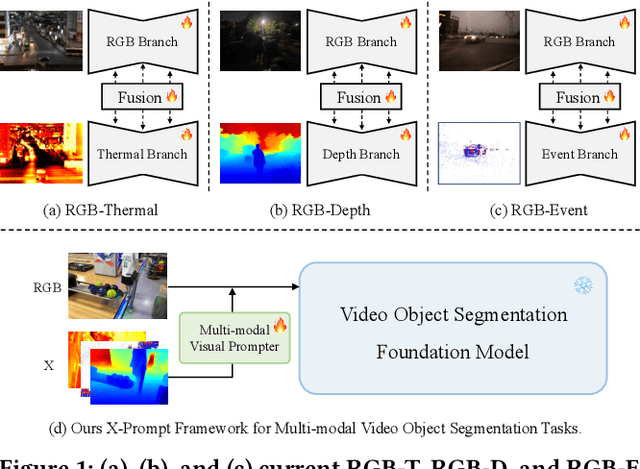
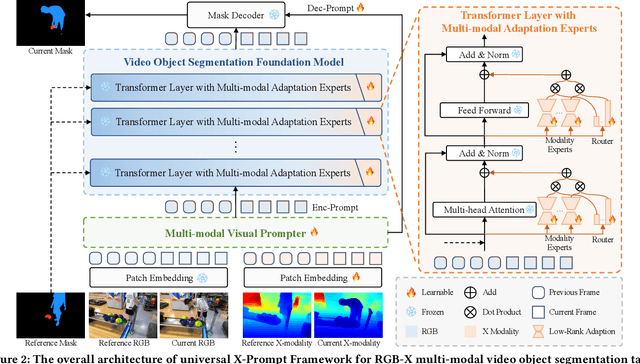
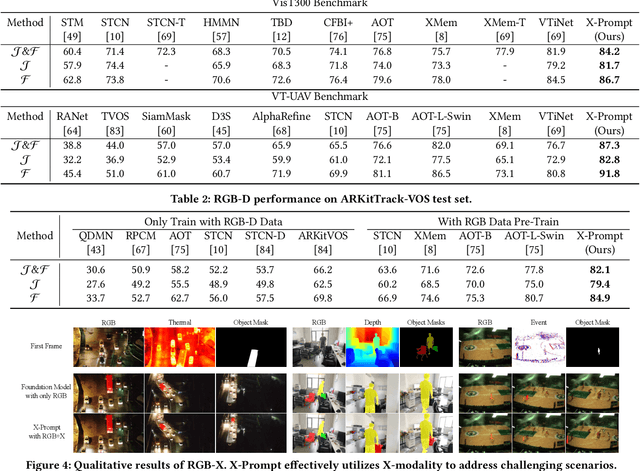

Abstract:Multi-modal Video Object Segmentation (VOS), including RGB-Thermal, RGB-Depth, and RGB-Event, has garnered attention due to its capability to address challenging scenarios where traditional VOS methods struggle, such as extreme illumination, rapid motion, and background distraction. Existing approaches often involve designing specific additional branches and performing full-parameter fine-tuning for fusion in each task. However, this paradigm not only duplicates research efforts and hardware costs but also risks model collapse with the limited multi-modal annotated data. In this paper, we propose a universal framework named X-Prompt for all multi-modal video object segmentation tasks, designated as RGB+X. The X-Prompt framework first pre-trains a video object segmentation foundation model using RGB data, and then utilize the additional modality of the prompt to adapt it to downstream multi-modal tasks with limited data. Within the X-Prompt framework, we introduce the Multi-modal Visual Prompter (MVP), which allows prompting foundation model with the various modalities to segment objects precisely. We further propose the Multi-modal Adaptation Experts (MAEs) to adapt the foundation model with pluggable modality-specific knowledge without compromising the generalization capacity. To evaluate the effectiveness of the X-Prompt framework, we conduct extensive experiments on 3 tasks across 4 benchmarks. The proposed universal X-Prompt framework consistently outperforms the full fine-tuning paradigm and achieves state-of-the-art performance. Code: https://github.com/PinxueGuo/X-Prompt.git
General Compression Framework for Efficient Transformer Object Tracking
Sep 26, 2024



Abstract:Transformer-based trackers have established a dominant role in the field of visual object tracking. While these trackers exhibit promising performance, their deployment on resource-constrained devices remains challenging due to inefficiencies. To improve the inference efficiency and reduce the computation cost, prior approaches have aimed to either design lightweight trackers or distill knowledge from larger teacher models into more compact student trackers. However, these solutions often sacrifice accuracy for speed. Thus, we propose a general model compression framework for efficient transformer object tracking, named CompressTracker, to reduce the size of a pre-trained tracking model into a lightweight tracker with minimal performance degradation. Our approach features a novel stage division strategy that segments the transformer layers of the teacher model into distinct stages, enabling the student model to emulate each corresponding teacher stage more effectively. Additionally, we also design a unique replacement training technique that involves randomly substituting specific stages in the student model with those from the teacher model, as opposed to training the student model in isolation. Replacement training enhances the student model's ability to replicate the teacher model's behavior. To further forcing student model to emulate teacher model, we incorporate prediction guidance and stage-wise feature mimicking to provide additional supervision during the teacher model's compression process. Our framework CompressTracker is structurally agnostic, making it compatible with any transformer architecture. We conduct a series of experiment to verify the effectiveness and generalizability of CompressTracker. Our CompressTracker-4 with 4 transformer layers, which is compressed from OSTrack, retains about 96% performance on LaSOT (66.1% AUC) while achieves 2.17x speed up.
KAN-HyperpointNet for Point Cloud Sequence-Based 3D Human Action Recognition
Sep 14, 2024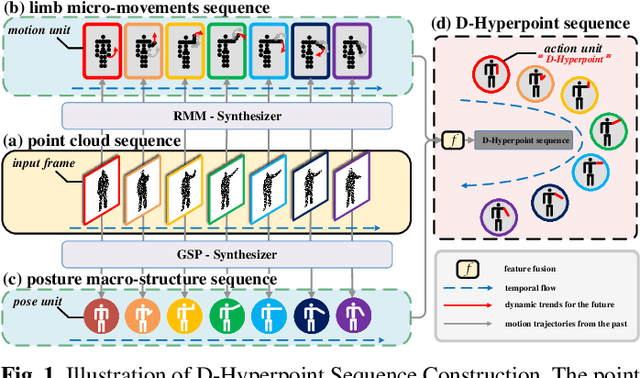
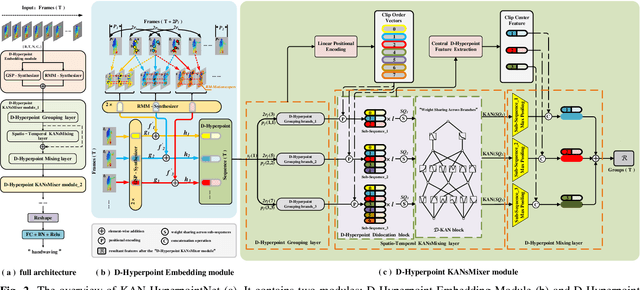
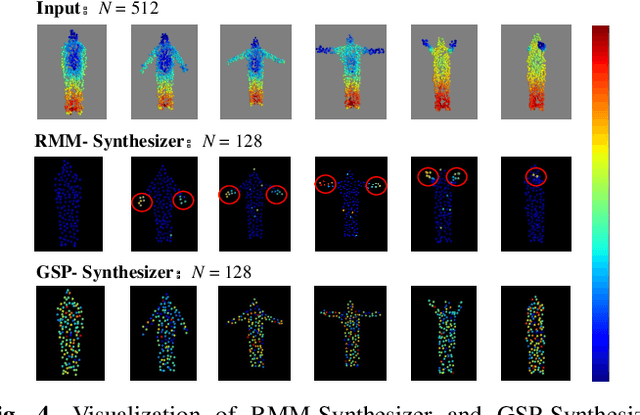
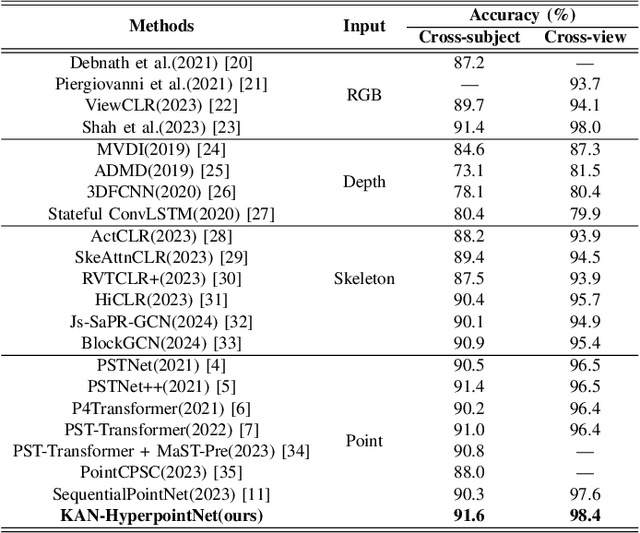
Abstract:Point cloud sequence-based 3D action recognition has achieved impressive performance and efficiency. However, existing point cloud sequence modeling methods cannot adequately balance the precision of limb micro-movements with the integrity of posture macro-structure, leading to the loss of crucial information cues in action inference. To overcome this limitation, we introduce D-Hyperpoint, a novel data type generated through a D-Hyperpoint Embedding module. D-Hyperpoint encapsulates both regional-momentary motion and global-static posture, effectively summarizing the unit human action at each moment. In addition, we present a D-Hyperpoint KANsMixer module, which is recursively applied to nested groupings of D-Hyperpoints to learn the action discrimination information and creatively integrates Kolmogorov-Arnold Networks (KAN) to enhance spatio-temporal interaction within D-Hyperpoints. Finally, we propose KAN-HyperpointNet, a spatio-temporal decoupled network architecture for 3D action recognition. Extensive experiments on two public datasets: MSR Action3D and NTU-RGB+D 60, demonstrate the state-of-the-art performance of our method.
TagOOD: A Novel Approach to Out-of-Distribution Detection via Vision-Language Representations and Class Center Learning
Aug 28, 2024
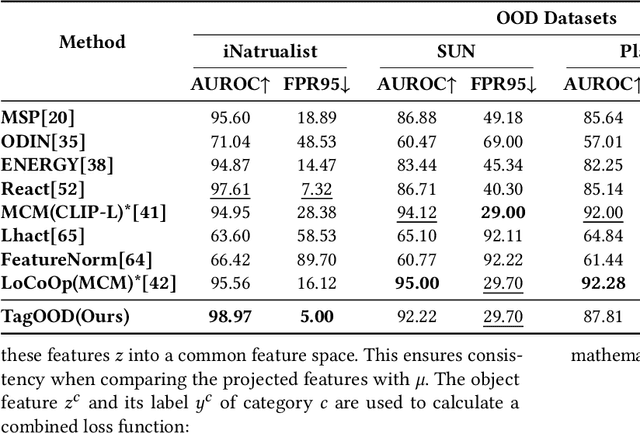


Abstract:Multimodal fusion, leveraging data like vision and language, is rapidly gaining traction. This enriched data representation improves performance across various tasks. Existing methods for out-of-distribution (OOD) detection, a critical area where AI models encounter unseen data in real-world scenarios, rely heavily on whole-image features. These image-level features can include irrelevant information that hinders the detection of OOD samples, ultimately limiting overall performance. In this paper, we propose \textbf{TagOOD}, a novel approach for OOD detection that leverages vision-language representations to achieve label-free object feature decoupling from whole images. This decomposition enables a more focused analysis of object semantics, enhancing OOD detection performance. Subsequently, TagOOD trains a lightweight network on the extracted object features to learn representative class centers. These centers capture the central tendencies of IND object classes, minimizing the influence of irrelevant image features during OOD detection. Finally, our approach efficiently detects OOD samples by calculating distance-based metrics as OOD scores between learned centers and test samples. We conduct extensive experiments to evaluate TagOOD on several benchmark datasets and demonstrate its superior performance compared to existing OOD detection methods. This work presents a novel perspective for further exploration of multimodal information utilization in OOD detection, with potential applications across various tasks.
Improving Factuality in Large Language Models via Decoding-Time Hallucinatory and Truthful Comparators
Aug 22, 2024



Abstract:Despite their remarkable capabilities, Large Language Models (LLMs) are prone to generate responses that contradict verifiable facts, i.e., unfaithful hallucination content. Existing efforts generally focus on optimizing model parameters or editing semantic representations, which compromise the internal factual knowledge of target LLMs. In addition, hallucinations typically exhibit multifaceted patterns in downstream tasks, limiting the model's holistic performance across tasks. In this paper, we propose a Comparator-driven Decoding-Time (CDT) framework to alleviate the response hallucination. Firstly, we construct hallucinatory and truthful comparators with multi-task fine-tuning samples. In this case, we present an instruction prototype-guided mixture of experts strategy to enhance the ability of the corresponding comparators to capture different hallucination or truthfulness patterns in distinct task instructions. CDT constrains next-token predictions to factuality-robust distributions by contrasting the logit differences between the target LLMs and these comparators. Systematic experiments on multiple downstream tasks show that our framework can significantly improve the model performance and response factuality.
 Add to Chrome
Add to Chrome Add to Firefox
Add to Firefox Add to Edge
Add to Edge